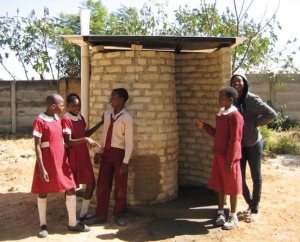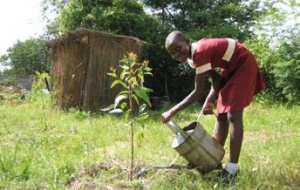Teaching ecological sanitation in schools - School sanitation story from Zimbabwe
Country: Zimbabwe
Contents
Students take a hands-on role in their own sanitation systems
Basic data:
Students at the Chisungu Primary School in Epworth in Zimbabwe were taught both how to construct toilets and handwashing devices and how to reuse diluted urine as fertilizer. Designs of toilets and handwashing devices developed for this project are now used in other parts of Zimbabwe and beyond.
The project and the experiences:
In Zimbabwe, simply teaching children about sanitation and hygiene in the classroom wasn’t enough – instead students got hand-on experience in both building their own toilets and beneficially reusing their own urine through a project supported by the Stockholm Environment Institute and implemented by Peter Morgan and Annie Kanyemba of Aquamor (Private) Limited between 2008 and 2010.
Selected pupils at the Chisungu Primary school, in Epworth Zimbabwe, were taught in class about a variety of ecological toilets and then also learned how to build both an Arborloo and a Fossa alterna. However most attention was paid to the construction of Blair VIP (ventilated improved pit) toilets, as this is the technology supported by the government in Zimbabwe. In Zimbabwe the Blair VIP forms part of the school curriculum, and most school children know the name Blair and also how it works. Many thousands of schools use the Blair VIP toilet, built as a multi-compartment unit while the single compartment unit is more typically built in households. The larger and more complex the multi-compartment units built by artisans, the more difficult it is for pupils to build. However, refinements were made to the design and construction method of the single unit making it much cheaper and easier to build. The students built many working units with great pride that continue to be used today. In addition, the students were taught to build many accessories to the toilet including hand washing devices and even pedestals.
The students were also taught the principles of using diluted urine as a fertilizer in the growth of vegetables, maize, and trees in gardens, orchards and woodlots. At first simple experiments were performed in small circular gardens called ring beam gardens. These revealed quickly and simply what a dramatic effect diluted urine (which contains much nitrogen) has on the growth of green vegetables and maize. These experiments were then extended to larger scale trials in gardens and maize fields. This led to the pupils using the same methods in planting and growing trees in woodlots and orchards and even single trees planted near toilets. In all cases growth of the plants was significantly enhanced by the application of diluted urine compared to watering alone.
Whilst this work was carried out at only one school, the benefits have been considerable beyond just that school. The simpler and lower cost BVIPs, developed in the project for school pupils, have now been adopted by the Government of Zimbabwe for use in rural areas. The work also demonstrated that single units could be successfully used in schools in place of multi-compartment units. The construction of the simpler BVIP was ideally suited to practical hands-on training of brick construction and cement application, taught in schools. This work was also linked to the development of an upgradeable series of BVIP toilets which is also now being employed by the GOZ, and the simple hand washing devices, developed during the study, are now used in several countries. In a self-funded continuation of the project, toilets were restyled so they could easily be emptied (with skilled specialists) and the pit contents are processed and used in tree pits in orchards and woodlots.
The key lessons of the story:
The students were involved into the whole process, they became active participants during the implementation. Thus the students not only learned sustainable sanitation solutions, but they are tend to be more committed to nature protection in the future.
Contribution to the SuSanA sustainability criteria
Socially acceptable and institutionally appropriate: Involving children in hands-on training of construction was fun and created ownership of the systems that will have positive impacts on O&M. They also learn skills for life.
Protect the environment and natural resources: These students are making use of easily available resources for productive use.
Technically appropriate including O&M and be financially and economically viable: Simple and scalable technologies led to broader adoption and implementation by the government of Zimbabwe.
Project details
Project location: Chisungu Primary School in Epworth, Zimbabwe
Implementation: Aquamor (Private) Limited
Supporter: SEI Stockholm
Aquamor (Private) Limited is a small private research and development company based in the city of Harare, the capital of Zimbabwe. Most of the research work has been undertaken in Zimbabwe, but the results of this are being applied in several countries in Africa as well as Zimbabwe. The main role of Aquamor is to explore new ideas, concepts and technologies which move the “state of the art” of this sector forward.
The Stockholm Environment Institute is an international non-profit research organization that has worked with environment and development issues from local to global policy levels for a quarter of a century. SEI works to shift policy and practice towards sustainability.
Contact
Peter Morgan
Aquamor (Private) Limited
aquamor![]() mweb.co.zw
mweb.co.zw
aquamor.info
Annie Kanyemba
kanyembaannie![]() yahoo.com
yahoo.com




